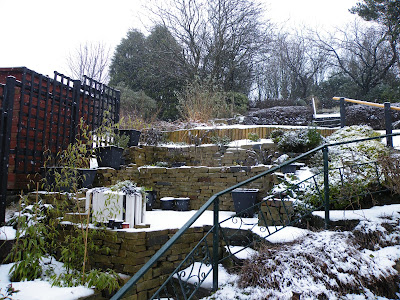 Although it was not originally really a conscious element of the garden's design I have really embraced the idea of having a recurring theme that ties together the different rooms. The use of the black grasses as a leitmotif does give the whole garden some coherence. Their correct full name is ophiopogon planiscapus 'Nigrescens'
Although it was not originally really a conscious element of the garden's design I have really embraced the idea of having a recurring theme that ties together the different rooms. The use of the black grasses as a leitmotif does give the whole garden some coherence. Their correct full name is ophiopogon planiscapus 'Nigrescens'The first of our black grasses where planted at the front of the grass border, they are intended to make a clear definition of where the lawn ends and the border begins. However, because they did so well and they help to set off other plants they have gradually been incorporated into other beds around the garden.
 |
| pot on steps leading to front door |
It is because it grows from short rhizomes from which the tufts of grass like leaves develop, that it is very easy to propagate. All our black grass has come from just a few specimens. It is native to Japan, where it grows on open and forested slopes so is plainly suited to our climate.



















